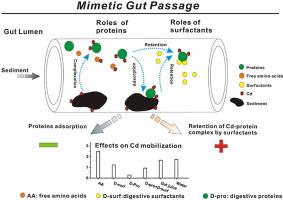Environmental Pollution ( IF 7.6 ) Pub Date : 2020-07-02 , DOI: 10.1016/j.envpol.2020.115149 Xing Wu 1 , Paul L Klerks 2 , Ran Bi 3 , Wen-Hua Liu 3 , Zi-Dan Yuan 1 , Xu Ma 1 , Guo-Qing Zhang 1 , Shao-Feng Wang 1 , Yong-Feng Jia 1

|
Marine deposit feeders are of ecological significance in transferring sedimentary Cd along aquatic food chains. A key process for this transfer is these organisms’ dietary uptake of Cd via solubilization of Cd present in ingested contaminated sediment. To better understand the bioavailability of sedimentary Cd to deposit feeders, the present study used in vitro extraction experiments to explore the contribution of different digestive agents (proteins, amino acids and surfactants) to the solubilization of Cd from sediment collected in a highly-contaminated Chinese bay. This was done for various commercially-available mimetic digestive agents (the protein BSA, a mixture of amino acids, and the surfactants rhamnolipid and SDS), and for proteins and surfactants collected from the gut juice of a sipunculan worm. The Cd mobilization capacity of BSA was significantly higher than that of the amino acids and the commercial surfactants. In the presence of BSA, > 70% of the released Cd became associated with this protein. In contrast, the digestive proteins from the sipunculan had a lower Cd mobilization capacity than was the case for the other digestive agents and the majority of the released Cd (∼80%) was associated with small molecular weight fractions. The differences in Cd mobilization between the BSA and the digestive proteins were attributed to differences in their sediment-adsorption tendencies and their Cd-complexing capacities. While the digestive surfactants had minor effects on the release of sedimentary Cd, they significantly enhanced Cd mobilization by the digestive proteins when both were present simultaneously. Our results suggest that the characteristics of proteins should be considered when using commercially-available mimetic digestive agents to explore Cd bioavailability in sediments. Furthermore, digestive surfactants seem to have important effects on the solubilization of Cd during gut passage by reducing the adsorption of the digestive proteins to the sediments.











































 京公网安备 11010802027423号
京公网安备 11010802027423号